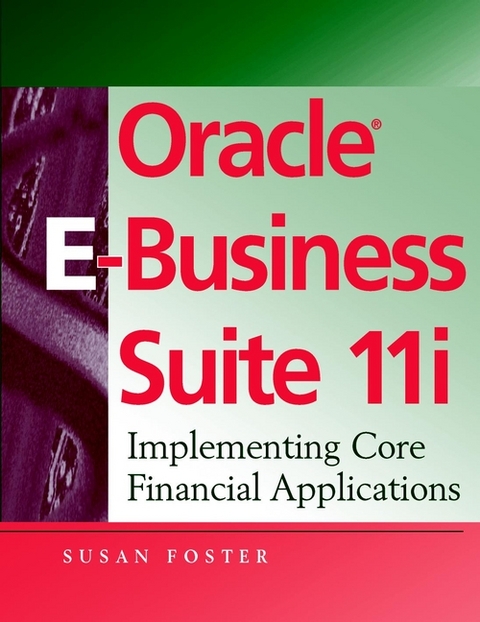
Oracle e-Business Suite 11i
John Wiley & Sons Inc (Verlag)
978-0-471-41205-2 (ISBN)
- Titel ist leider vergriffen;
keine Neuauflage - Artikel merken
Whether your company has been a dedicated Oracle customer or is considering adopting the powerful capabilities of this latest version, Oracle E-Business Suite 11i: Implementing Core Financial Applications will help you quickly master the program and turn it into one of your business's most powerful back-office tools.
SUSAN FOSTER was one of Oracle Corporation's first financial system consultants. In 1990, she became an independent Oracle applications consultant, starting her own consulting firm in 1994. Her Oracle applications project experience includes being the project leader for twenty-plus implementations, one accounting flexfield structure change, and one calendar change (neither through a reimplementation). She has presented papers at eight national and regional Oracle Application User Group Conferences.
Introduction. Oracle Application Methodology. Hardware. Software. Data. People. Procedures. Project Methodology. Chapter 1. Concepts. Overview. Oracle E-Business Suite 11i Integration. Oracle Glossary. Chapter 2. Oracle Applications Navigation. Overview. Accessing Oracle Applications. Select Responsibility. Navigate. Data Entry Mode. Query Mode. Chapter 3. Setting Up Oracle Applications. Overview. System Administrator Step 1.1: Responsibility. System Administrator Step 1.2: User. System Administrator Step 1.3: Printer. System Administrator Step 1.4: Profile Values. System Administrator Step 1.5: Concurrent Processes. Chapter 4. Flexfields. Overview. Accounting Flexfield. Descriptive Flexfields. Accounting Flexfields Step 2.1: Setup. Accounting Flexfields Step 2.2: Values. Accounting Flexfields Step 2.3: Cross-Validation Rules. Chapter 5. General Ledger. Overview. Using General Ledger. Setup. General Ledger Step 3.1: Calendar. General Ledger Step 3.2: Set of Books. General Ledger Step 3.3: Profile Values. General Ledger Step 3.4: Intercompany Account. General Ledger Step 3.5: Open Period. Journals. Budgets. Inquiry and Reporting. Period-End Process. Chapter 6. Multi-Org. Overview. Setup. Multi-Org Step 4.1: Human Resources User Profile. Multi Org Step 4.2: Locations. Multi Org Step 4.3: Organizations. Multi Org Step 4.4: Responsibilities. Multi Org Step 4.5: Profile Values. Multi Org Step 4.6: Adamin. Multi Org Step 4.7: Other Profile Values. Chapter 7. Payables. Overview. Setup. Payables Step 5.1: Lookup Codes. Payables Step 5.2: Select Set of Books. Payables Step 5.3: Profile Values. Payables Step 5.4: Payment Terms. Payables Step 5.5: Financial Options. Payables Step 5.6: Expense Report Template. Payables Step 5.7: Bank Accounts. Payables Step 5.8: Payables Options. Payables Step 5.9: Reporting Entities. Payables Step 5.10: Open Period. Suppliers. Invoices. Credit Memos. Matching to Purchasing. Prepayments. Employee Expense Report. Recurring Invoice. Payments. Inquiry and Reporting. Period Process. Open/Close Period. Chapter 8. Receivables. Overview. Setup. Receivables Step 6.1: Flexfields. Receivables Step 6.2: System Options. Receivables Step 6.3: Payment Terms. Receivables Step 6.4: Open Period. Receivables Step 6.5: AutoAccounting. Receivables Step 6.6: Transaction Types: Credit Memos. Receivables Step 6.7: Transaction Source. Receivables Step 6.8: Collectors. Receivables Step 6.9: Approval Limits. Receivables Step 6.10: Receivable Activities. Receivables Step 6.11: Bank Accounts. Receivables Step 6.12: Receipt Classes and Payment Methods. Receivables Step 6.13: Receipt Sources. Receivables Step 6.14: Statement Cycles. Receivables Step 6.15: Profile Values. Receivables Step 6.16: Customer Profile Class. Receivables Step 6.17: Customers. Receivables Step 6.18: Remit-to Addresses. Receivables Step 6.19: (Standard) Memo Lines. Receivables Step 6.20: Tax Codes. Customers. Invoices. Credit Memos. Printing. Receipts. Inquiry and Reporting. Period Process. Index.
| Zusatzinfo | Illustrations |
|---|---|
| Verlagsort | New York |
| Sprache | englisch |
| Maße | 192 x 237 mm |
| Gewicht | 632 g |
| Einbandart | Paperback |
| Themenwelt | Informatik ► Datenbanken ► Oracle |
| Wirtschaft ► Betriebswirtschaft / Management | |
| ISBN-10 | 0-471-41205-8 / 0471412058 |
| ISBN-13 | 978-0-471-41205-2 / 9780471412052 |
| Zustand | Neuware |
| Informationen gemäß Produktsicherheitsverordnung (GPSR) | |
| Haben Sie eine Frage zum Produkt? |
aus dem Bereich

